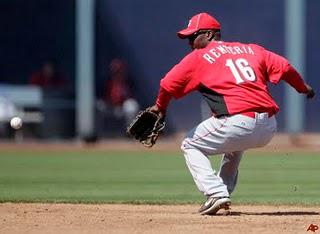
Handling balls in the 5.5 hole is what
separates the men from the boys.
With a runner on first base in a possible double-play situation, the shortstop will play at “double-play depth” which, generally speaking (there are some exceptions), means playing “two in and two over.” This means that the shortstop takes two steps in towards the plate and then two steps over towards second base. The number of steps can vary depending on the fielder and the situation but the principle of the give-and-take is the same: give up a hit in the hole to allow the fielder to get to the bag on time for a double-play. “Reverse double-play depth” has the shortstop play two steps in towards the plate and then two steps over towards third base. This allows the shortstop to not only get to more balls in the 5.5 hole but also allows him to cut them off quicker in order to be able to throw the ball to first base sooner. Of course, this obviously leaves the middle of the field more open for ground balls to get through. However, balls hit to the shortstop’s left are a bit easier because they are glove-side, their momentum is heading more towards first base, and the throw is generally going to be a little shorter.
This positioning by the shortstop is certainly not used for every hitter. As a former shortstop, I mostly used it on a left handed slap hitter who commonly tries to hit the 5.5 hole and beat out the throw to first. Another time it may be used is when the shortstop lacks some arm strength and wants to make sure more balls are hit to his glove side.
Properly handling the 5.5 hole is another "separator." Separators are those plays in baseball that are routinely made at the major league level but not so much at the lower levels. The play separates the men from the boys.

